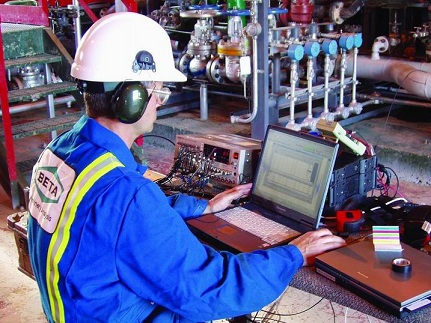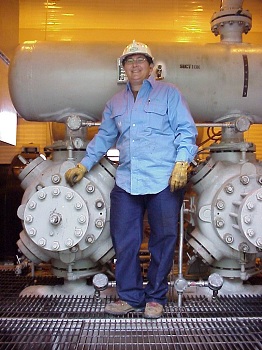Services
- Static Equipment & Structures (Piping Vibration & Fatigue)
- Acoustic Fatigue Assessment for Blowdown Systems
- Acoustic-Induced Vibration (AIV) Analysis
- Finite Element Analysis (FEA) and Computational Fluid Dynamics (CFD)
- Flow-Induced Turbulence (FIT) Analysis
- Flow-Induced Vibration (FIV) Analysis
- Multiphase and Slug Flow Analysis
- Pipe Stress Analysis
- Piping Vibration and Integrity Assessment
- Review & Design Support Services
- Small-Bore Connections (SBC) Assessment
- Structural Vibration and Dynamic Design Analysis
- Subsea Piping Vibration
- Thermal Striping
- Tube Failure Analysis
- Veridian AM
- Veridian VS
- Vibration Inspection Program
- Water Hammer Analysis
- Machinery Analysis
- Bottle Sizing Service
- Compressor Package Engineering
- Finite Element Analysis (FEA) and Computational Fluid Dynamics (CFD)
- Foundation Design and Dynamic Analysis
- Fuel Gas Compressor Piping Transient Analysis
- Lateral Vibration Analysis
- Pipe Stress Analysis
- Pulsation & Mechanical Analysis: Reciprocating Compressor
- Pulsation & Mechanical Analysis: Reciprocating Pump
- Pulsation & Mechanical Analysis: Screw Compressor
- Pump RCF Analysis
- Review & Design Support Services
- Shell Transverse Acoustical (STA) Analysis
- Skid Design and Analysis
- Surge Control Design for Centrifugal Compressor Systems
- Torsional Vibration Analysis (TVA)
- Field Engineering & Troubleshooting
- Finite Element Analysis (FEA) and Computational Fluid Dynamics (CFD)
- Human Vibration
- Motion Amplification Vibration Analysis
- Noise Troubleshooting
- Performance Assessment (Thermodynamic)
- PostPro – field data processing and analysis
- Structural Vibration Troubleshooting
- Thermal Striping
- Troubleshooting, Root Cause Analysis (RCA)
- Veridian iDAC
- Vibration Inspection Program
Vibration Inspection Program
Site Assessment, Piping Integrity, Baseline Survey, AVIFF
This inspection program identifies integrity risks due to vibration-induced piping failures and is becoming a core component in an integrity management system. The assessment includes baseline vibration surveys of main piping, compressors, pumps, other rotating equipment, small-bore connections, vessels, nozzles, piping supports, skids, fire water systems, wellheads, and foundations. This Inspection Program can be part of the Energy Institute 2008 Guidlines for the avoidance of vibration induced fatigue failure in process pipework (AVIFF).
A vibration inspection such as this is not related to traditional CBM programs. This inspection service requires specialized tools, training, and advanced analysis (as outlined below).
 |
|
Contents [ hide ]
1 Application
Examples of Wood’s Inspection Service:
- Verification that vibration will not impact the facilities integrity system. This includes compressor stations, pumping facilities, gas plants, refineries and petro-chemical facilities. This can be applied on existing facilities, or can be implemented during the design phase for new projects.
- Start-up check for new compressor and pump packages.
- Field inspection for offshore platforms and FPSOs, given the higher risk issues facing these production facilities.
- System Integrity inspection of clamps, bracing, bolts, flange alignment, piping supports, and other components.
- Small-bore piping audit, if a more focused inspection program is required.
2 Requirements and Scope
2.1 Technical Requirements
Caution: The Piping and Machinery Vibration Inspection is not related to traditional CBM programs. Specialized skills are needed. There is often the perception that technicians doing CBM programs can also perform this assessment. Unfortunately the two skill sets are very different.
For CBM programs, the inspection service is typically conducted by technicians with basic vibration skills who follow a defined route to measure bearings on pumps, compressors, motors. The technicians compare current vibration patterns with previous measurements using trending software.
The inspection of vibration and stresses described in Section 2.2 below requires advanced engineering expertise. The techniques, training, experience, tools, and post-processing software are different than that used for CBM. For example, advanced vibration engineering, transient analysis, pulsation analysis, finite element analysis (FEA), operating deflection shape (ODS), and other skills are required.
2.2 Scope
The scope of the site assessment is based on:
- Integrity audit or customer requirements
- Machinery size, type, and application
- Product process (steady state vs. fluctuating process, including transient conditions)
- Recommendations from a design review (per Energy Institute Guideline) that highlights high risk areas (e.g., high Likelihood of Failure or LOF)
- FEA and advanced analysis of high risk locations due to issues from pulsation, water hammer, surge, or other issues
- Customer’s reporting requirements; Although standardized reports are typically provided, many customers have unique audit and documentation requirements
The inspection service includes these steps:
- First, a piping vibration inspection program starts with a risk assessment to identify which locations should be included. The Energy Institute (EI) Guideline (the recommended approach to identify and resolve piping vibration risks) can be used to evaluate the system and identify high risk locations. Based on our experience, Wood has further developed the EI approach to provide practical techniques to pinpoint high risk locations.
- Second, the field inspection team measures vibration, mechanical natural frequencies (MNF), and stress (if required) at these locations using specialized hardware and software tools. The inspection program must consider transient related vibration due to equipment or processes starting or stopping, or changing operating conditions. For example, changes in speed or flow can create resonance conditions that amplify the vibration above safe limits.
Documenting the inspection program should tie into the operator’s Asset Integrity Management (AIM) database as part of the operator’s Integrity Operating Window (IOW) philosophy. This ensures risks are identified, properly managed, and not left unattended.
3 Wood Advantages
- Audited safety program that meets our customers’ HS&E requirements
- Expert staff with unique skills, training, and experience with liquid and gas systems
- Specialists in piping vibration design and field services, include ongoing industry funded research
- Global support, with offices in the USA, Canada, Asia and responsive support to other regions
- Specialized software tools to ensure efficient data processing and comprehensive results
- Equipment calibration and testing
- Advanced vibration and engineering skills, customer training, and project management support
- Proprietary simulation software for pulsations (acoustical analysis), compressor surge, mechanical analysis, torsional analysis, water hammer, and other applications
- Technical support and review by Principal Engineers
4 Benefits to Owner
- Judicious site assessment of equipment and piping is vital to avoid integrity risks such as piping failures
- Independent review by advanced vibration experts
- Report and/or database of assessment results and recommendations
- Wood‘s project planning and execution support frees up customer resources
 |
 |
 |
||
|
Experts in Reciprocating/Rotating Machinery and Piping Systems |
Integrity Assessment of Piping System (Vibration) |
Multichannel Data Acquisition Used for |
5 Key Words
- Baseline Vibration Assessment
- Piping Vibration Inspection
- Vibration Audit
- Vibration Surveys
- Vibration Inspection
- Vibration Baseline Measurements
Free webinar
Learn how to select and design vibration control solutions that work – using real-world data and case studies. Register now




